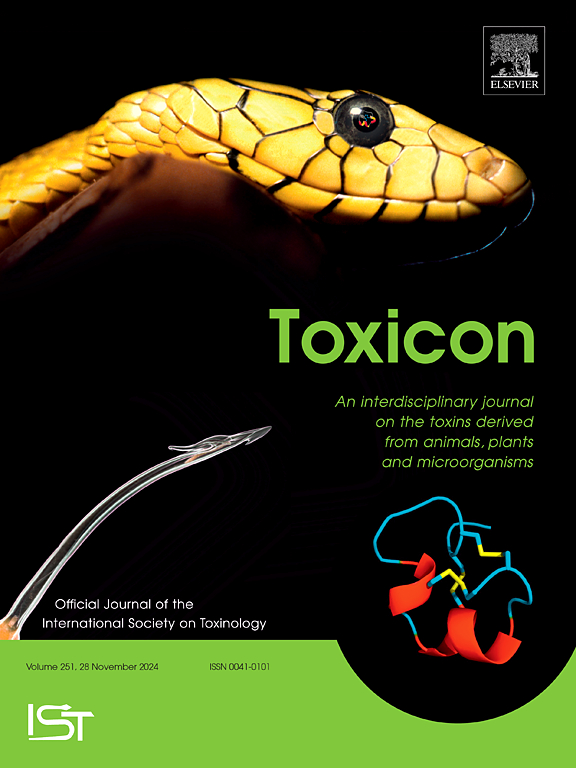载巯基细菌纤维素纳米颗粒减轻苹果汁中霉菌毒素棒曲霉素引起的肠道损伤。
IF 2.6
4区 医学
Q2 PHARMACOLOGY & PHARMACY
引用次数: 0
摘要
棒曲霉素(PAT)是一种有毒的真菌代谢物,可以通过改变微生物群组成直接破坏肠道屏障和肠道稳态。虽然有一些体外控制PAT的尝试,但目前很少有利用体内试验改善展霉素引起的肠道损伤的研究。本研究通过对xyacetobacter xyum进行动态发酵,得到球形细菌纤维素纳米颗粒配方,制备细菌纤维素纳米颗粒(BCNs),然后用3-巯基四乙氧基硅烷修饰生成BCN(SH),以增加体外对PAT的吸附。BCN(SH)s具有保护小肠微生物屏障的作用,可被拟杆菌门、厚壁菌门和放线菌等微生物利用,产生短链脂肪酸(SCFAs)。BCN(SH)s是一种很有前景的可食用材料,可用于减轻展霉素引起的肠道损伤,但尚未在其他肠道中毒模型中进行测试。本文章由计算机程序翻译,如有差异,请以英文原文为准。

Sulfhydryl-loaded bacterial cellulose nanoparticles alleviated intestinal damage caused by mycotoxin patulin in apple juice
Patulin (PAT), a toxic fungal metabolite, can directly damage the intestinal barrier and gut homeostasis via altering microbiota composition. Although there are several attempts for the control of PAT in vitro, there are currently few studies on the improvement of intestinal damage caused by patulin using in vivo assay. In this study, a nanoparticle formulation of spherical bacterial cellulose was obtained by dynamic fermentation of Acetobacter xylinum to prepare bacterial cellulose nanoparticles (BCNs) and then modified with 3-mercaptotetraethoxysilane to produce BCN(SH), to increase PAT adsorption in vitro. Meanwhile, results revealed that BCN(SH)s protected the small intestinal microbial barrier and can be used by microorganisms, such as Bacteroides, Firmicutes, and Actinomycetes, to produce short-chain fatty acids (SCFAs). BCN(SH)s appears as a promising edible material that can be used to alleviate intestinal damage from patulin, and has yet to be tested in other gut intoxication models.
求助全文
通过发布文献求助,成功后即可免费获取论文全文。
去求助
来源期刊

Toxicon
医学-毒理学
CiteScore
4.80
自引率
10.70%
发文量
358
审稿时长
68 days
期刊介绍:
Toxicon has an open access mirror Toxicon: X, sharing the same aims and scope, editorial team, submission system and rigorous peer review. An introductory offer Toxicon: X - full waiver of the Open Access fee.
Toxicon''s "aims and scope" are to publish:
-articles containing the results of original research on problems related to toxins derived from animals, plants and microorganisms
-papers on novel findings related to the chemical, pharmacological, toxicological, and immunological properties of natural toxins
-molecular biological studies of toxins and other genes from poisonous and venomous organisms that advance understanding of the role or function of toxins
-clinical observations on poisoning and envenoming where a new therapeutic principle has been proposed or a decidedly superior clinical result has been obtained.
-material on the use of toxins as tools in studying biological processes and material on subjects related to venom and antivenom problems.
-articles on the translational application of toxins, for example as drugs and insecticides
-epidemiological studies on envenoming or poisoning, so long as they highlight a previously unrecognised medical problem or provide insight into the prevention or medical treatment of envenoming or poisoning. Retrospective surveys of hospital records, especially those lacking species identification, will not be considered for publication. Properly designed prospective community-based surveys are strongly encouraged.
-articles describing well-known activities of venoms, such as antibacterial, anticancer, and analgesic activities of arachnid venoms, without any attempt to define the mechanism of action or purify the active component, will not be considered for publication in Toxicon.
-review articles on problems related to toxinology.
To encourage the exchange of ideas, sections of the journal may be devoted to Short Communications, Letters to the Editor and activities of the affiliated societies.
 求助内容:
求助内容: 应助结果提醒方式:
应助结果提醒方式:


